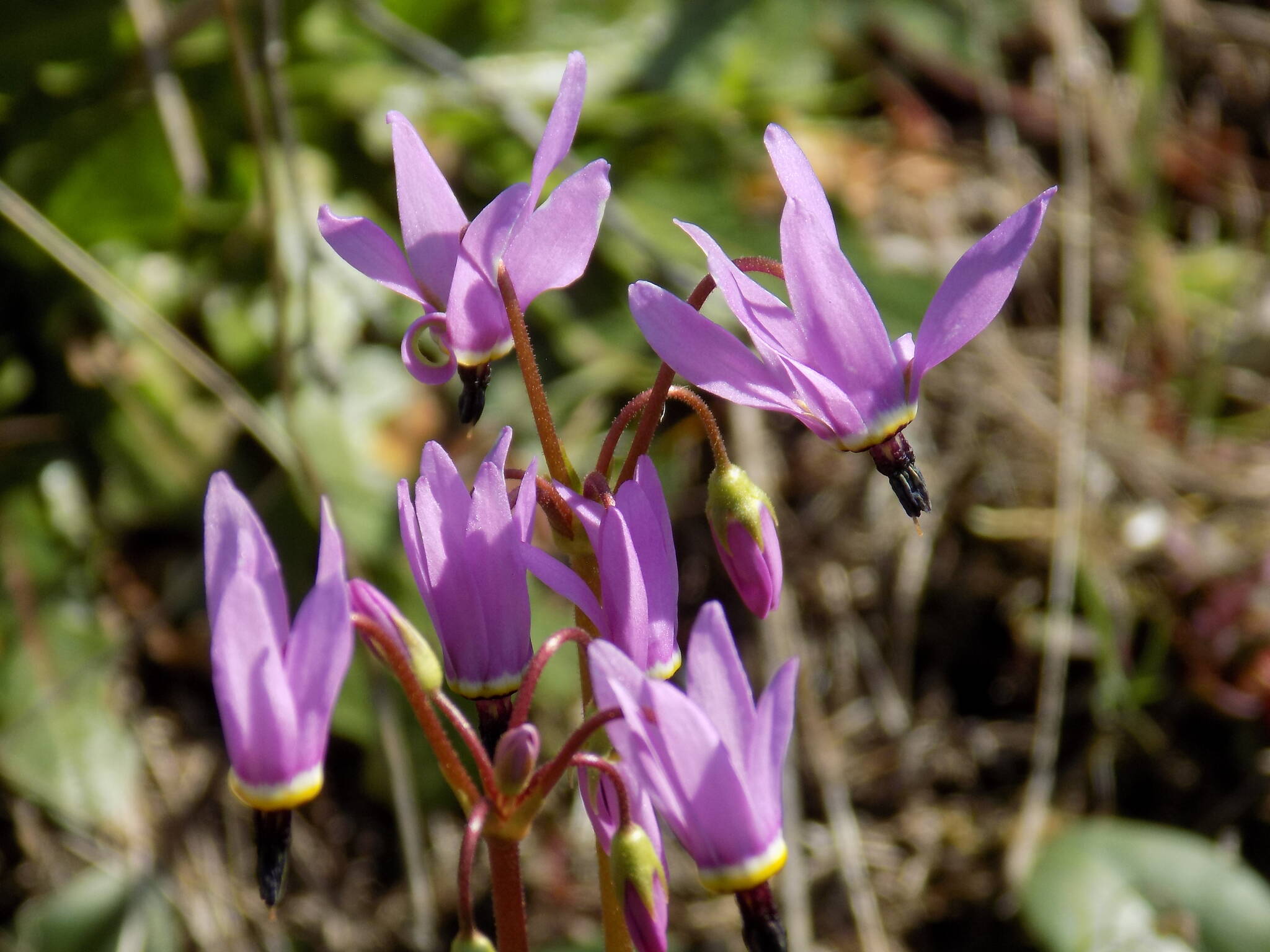Submitted by Russel Barsh, director of Kwiaht.
Among the first native wildflowers to appear each year, often as early as the spring equinox, pale purple Shooting Stars are vanishing from much of the San Juan Islands. They are not especially palatable to browsers such as deer, and they do not produce bulbs or corms that attract voles and other rodents. Shooting Stars are sensitive to disturbance, however, and they are not very good at dispersing. Their tiny, smooth, brown, angular seeds simply fall to the ground and germinate in place, ignored by birds and lacking the means to stick to the hairy coats of passing mammals and fuzzy socks of hikers. It is common to find Shooting Stars in small, dense perennial patches or isolated on tiny uninhabited islands.
Botanists originally gave this dainty plant a rather lofty name, Dodecatheon pulchellum, from the Greek words dodeka (“12”) and theoi (“gods”), and Latin pulchella (“pretty”): something like “pretty [flower] beloved of all the gods.” Quite a reputation to uphold! About 20 years ago, a more bacon-and-eggs scientific name was widely adopted: Primula pauciflora. Primula refers to Shooting Stars being among the “very first” spring flowers. Pauciflora is derived from the Latin paucus, meaning “few,” as in the English word “paucity.” Descriptive, but unromantic.
But what exactly is a Shooting Star? Primula pauciflora is now just one of eight superficially similar Primula species found in Washington state, and more widely across western Canada and the Pacific Coast from southeast Alaska to northern California, adapted to different kinds of habitats. Primula pauciflora, as it is now defined, is most often found along the coastlines of western Washington, including smaller islands of San Juan, Skagit and Island counties. This distribution suggests that Primula pauciflora is somewhat salt-tolerant. Other Primula species seem to prefer freshwater wetlands and streams, higher elevations such as the Cascade Crest or the dry prairies and near-desert conditions of parts of eastern Washington and Oregon. The physiological basis of these varied habitat preferences is not well studied or understood.
Indeed, it appears that San Juan County has two species of Shooting Stars: Primula pauciflora on small windswept islands, where salt tolerance is adaptive, and Primula hendersonii on dry hillslopes such as Mount Young and the Land Bank’s Westside Preserve, where salt spray is not a factor. And that is not the only surprising behavior of these ephemeral spring flowers.
Several Primula species, including pauciflora, have evolved an anatomical trick to give bumblebees an edge in pollination. Bumblebees are among the most efficient pollinators, in terms of the probability that any one pollen grain will be delivered to a female flower of the same species. Attracting bumblebees, or discouraging visits by other kinds of bees, means that a plant has to manufacture less pollen — a saving of metabolic energy.
How do Shooting Stars do it? Their delicate purple flowers end in a conical tube that holds pollen. Bumblebees are intelligent and learn from observation. One of their special abilities is “buzz pollination,” which involves sitting inside a bell-shaped flower and rapidly vibrating their wings. This produces a loud buzzing noise and shakes all the flower’s pollen into the bowl of the flower where the bee awaits. Nootka roses are a good bet if you want to see this behavior in the islands.
Bumblebees have learned that buzzing can also open the conical tubes of Shooting Stars so that they pour out their trapped pollen onto the bee’s fuzzy body!
Many patches of Shooting Stars in the islands have succumbed to a combination of encroaching Eurasian grasses and increased human traffic. Fire is not an option; experiments in California grasslands have shown that Shooting Stars can recover after a fire, but do not benefit from it. Indigenous peoples of the Pacific Northwest did not make much use of Shooting Stars, although most, if not all, species are edible; they were not a component of traditional Coast Salish Camas gardens. Unlike many Salish Sea wildflowers, Shooting Stars remained part of the undisturbed wildlands where there was a very light human touch.
On the other hand, Shooting Star seeds are easily collected, stored and germinated, making this wildflower a good bet for a reconstructed wildflower meadow that is both salt-tolerant and deer-resistant. Island gardeners and “meadow makers” should consider greater use of this “beloved flower of the gods,” especially on San Juan Island, where natural seed sources are still widespread and can be harvested with appropriate care from private lands.




